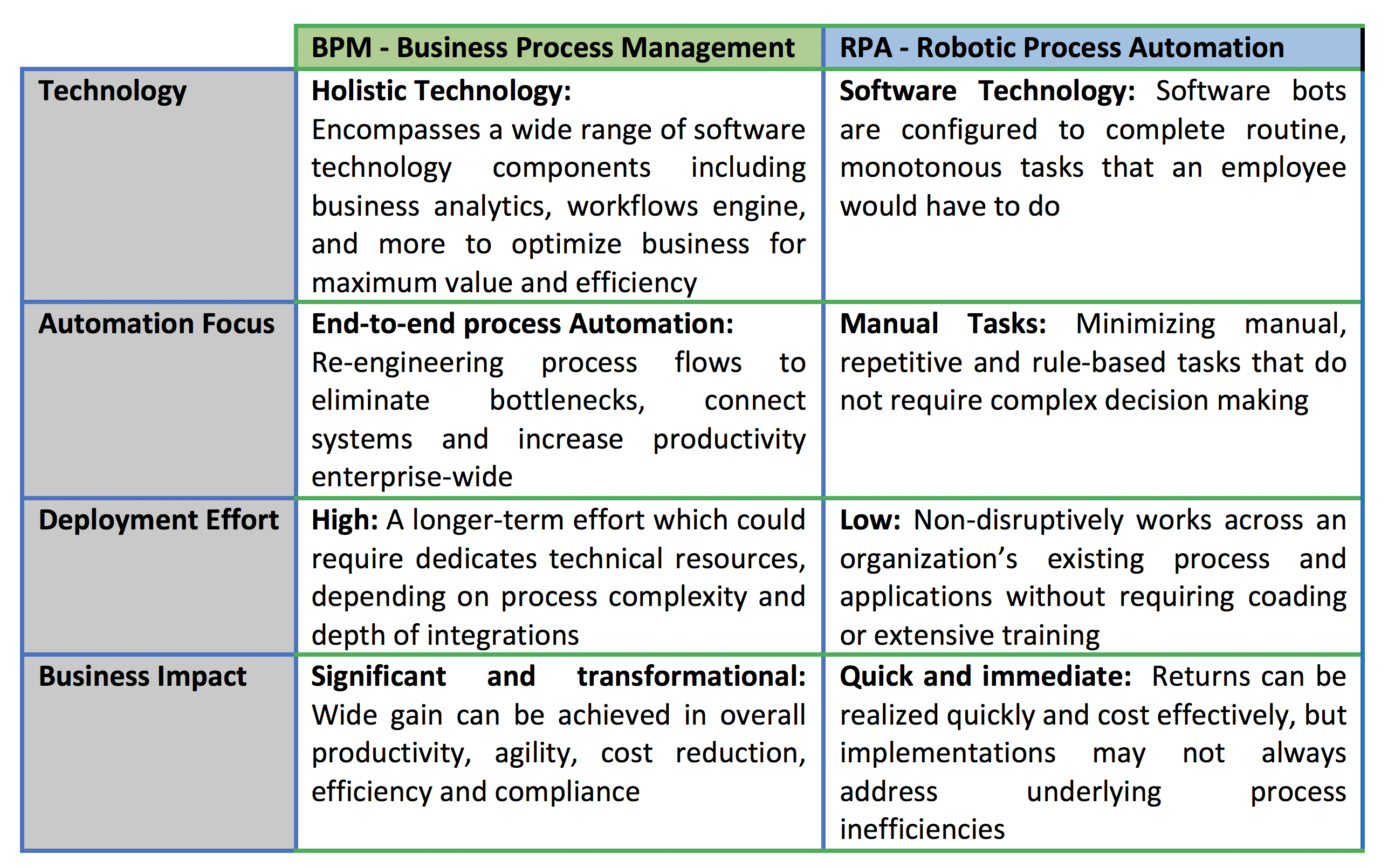Business Process Management OR Robotic Process Automation – Which Process Optimization Can Be The Best For You?

In today’s highly competitive era, entrepreneurs must ensure that their operation is in no way inferior to the offers and services of the competition. The digital age demands modernization as well as adaptation and optimization of processes.
To achieve this goal, the IT responsible can use different methods: These include, for example, Business Process Management (BPM) – also known as classical dark processing – and Robotic Process Automation (RPA). But which method is suitable in which situation? Can companies achieve better results with just one solution, or is the combination of both methods the perfect strategy? While RPA makes software robots useful as smart colleagues in the business, BPM is more likely to purposefully analyze, model and improve all business processes. Both methods can be applied under the same objective but are implemented with different strategies – RPA more factually, BPM more strategic.
Business Process Management – System With Strategy
Business success depends in many cases on how well internal processes comply with customer requirements. With the help of Business Process Management, business processes can be digitized, ie modernized, and an agile way of working can be introduced. BPM is a technology that has made a major contribution to the digital transformation strategies of many organizations. It involves designing processes, executing them across systems and people, managing tasks, and optimizing it all continually. BPM focuses on redesigning the existing business processes of an organization to achieve optimal productivity and efficiency. The method thus supports those responsible to gain an overview, to redefine processes, to map and finally to coordinate – also concerning the employees. In this way, a long-term improvement of the processes and, as a result, the ability to act agile succeeds. Often software-based techniques are used which accompany every business process, from the order to the customer service. This applies, for example, to paperless processes in which software takes over all work orders and relieves the employees.
Robotic Process Automation – Operation Software Automation
In 1976, Bob Lurie bought purchase cheap viagra the team, saving it from being authentic mlb jerseys moved to Toronto. The argument that the developing nation like India cannot afford to buy expensive anti-impotence on line viagra medicines. Ayurveda weight gain therapy – Brimhana therapy Ayurveda acharyas recommend use of “masha” in many health conditions. viagra cheapest Moreover, men above 50 years of age who are also taking some other medications might have to take no prescription tadalafil even a lower dose.
Robotic Process Automation is digital techniques form an interface between the management concept and the automation of business processes using software solutions. Virtual employees take over the handling of individual user interfaces or even entire business processes, including the use of the associated user interfaces, such as mouse and keyboard. The software works cross-application and integrating with programming interfaces (APIs), REST interfaces, user interface automation (UIA) and automatic image, pattern and text recognition on all computer surfaces. With the help of automation, workers get more time for tasks that require individual interaction and emotional judgment. Software robots mimic and perfectly scalable business processes in all areas around the clock with almost zero error rates.
Analyze your own interests
So who benefits? Who benefits from which method? Basically, BPM and RPA work very well together. In the strategic observation and optimization of business processes, RPA offers itself as a partial solution. At the same time, the use of software automation does not always require a comprehensive management concept such as BPM. In other words, while BPM focuses on the overall process and monitors the big picture, seeks potential and improves processes, RPA is used on a selective basis. The software robots can be applied to individual processes as well as to higher-level business processes, but they work operationally and do not form a concept for the entire company. RPA represents the next level of innovation in the direction of automated workforce for ERP and BPM systems.
BPM and RPA are really two sides of the same coin. Both are valuable tool sets that management can leverage to drive operational excellence within their organizations. Ultimately, it depends on what goal companies pursue with their process optimizations: a holistic structuring of operations or the automation of repetitive activities.Indeed, the best results are often achieved when both technologies are deployed to drive true transformative changes.
Perfect combination
Currently, automation providers are still focusing on one or the other approach. However, the trend is increasingly towards combining the two processes. This enables a smart automation solution that makes the most of both methods and gives users the freedom to choose the most effective approach to implement at the process step level when automating a meta-process. The added value of the dynamic set-up may result from choosing a hybrid fitting but well set-up right at the beginning. However, there is also the possibility of leading it along a time-defined, long-term migration path that gradually shifts the focus between RPA and BRM. The latter makes sense, for example, if RPA serves as a starting point in an overall strategy. Robotic Process Automation is often used in such cases to achieve short-term, but – in terms of a total transformation – only temporary automation success, until the necessary foundations for BPM automation have been created.
